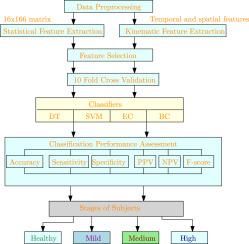Applied Soft Computing ( IF 8.7 ) Pub Date : 2020-06-22 , DOI: 10.1016/j.asoc.2020.106494 Balaji E. , Brindha D. , Balakrishnan R.

|
While diagnosing Parkinson’s disease (PD), neurologists often use several clinical manifestations of the subject and rate the severity level based on the Unified Parkinson Disease Rating Scale (UPDRS). This kind of rating largely depends on the expertise of the doctors, which is not only subjective but also inefficient. Hence, in this paper, a machine learning based gait classification system which can assist the clinician to diagnose the stages of PD is presented. Gait pattern, which plays a significant role in assessing the human mobility, is a significant biomarker to classify whether the subject is healthy or affected with PD. Hence, we utilize the vertical ground reaction force (VGRF) gait dataset and extract the minimal feature vector using the statistical analysis. Subsequently, the normal distribution of the data is validated using the Shapiro–Wilk test, and from the spatial and temporal features of gait pattern, the salient biomarkers are identified using the correlation based feature selection technique. Four supervised machine learning algorithms namely decision tree (DT), support vector machine (SVM), ensemble classifier (EC) and Bayes classifier (BC) are used for statistical and kinematic analyses which predict the severity of PD. The classifier efficacy quantified using the accuracy, sensitivity and specificity highlights that the proposed framework can effectively rate the severity of PD based on Hohen and Yahr (H&Y) scale. Moreover, comparing the accuracy of the proposed PD classification approach with those of the other state-of-the-art approaches, which utilized the same gait dataset, reveal that the proposed method outperforms several other PD classification methods.
中文翻译:

基于监督机器学习的步态分类系统,用于帕金森氏病的早期检测和阶段分类
在诊断帕金森氏病(PD)时,神经科医生经常使用该受试者的几种临床表现,并根据统一帕金森氏病评分量表(UPDRS)对严重程度进行评分。这种评级很大程度上取决于医生的专业知识,这不仅是主观的,而且效率很低。因此,在本文中,提出了一种基于机器学习的步态分类系统,该系统可以帮助临床医生诊断PD的阶段。步态模式在评估人类活动能力中起着重要作用,是一种重要的生物标记物,可以对受试者是否健康或受PD影响进行分类。因此,我们利用垂直地面反作用力(VGRF)步态数据集并使用统计分析提取最小特征向量。后来,使用Shapiro-Wilk检验验证数据的正态分布,并根据步态模式的时空特征,使用基于相关性的特征选择技术来识别显着的生物标志物。四种有监督的机器学习算法,即决策树(DT),支持向量机(SVM),集成分类器(EC)和贝叶斯分类器(BC)用于统计和运动学分析,以预测PD的严重性。使用准确性,敏感性和特异性进行量化的分类器功效突出表明,所提出的框架可以根据Hohen和Yahr(H&Y)量表有效评估PD的严重性。此外,将拟议的PD分类方法的准确性与使用相同步态数据集的其他最新方法的准确性进行了比较,



























 京公网安备 11010802027423号
京公网安备 11010802027423号